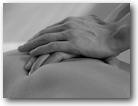Frequently asked questions and answers
Why haven’t I heard of Rolfing before?
"Myofascial Release" is now becoming more well known, Ida Rolf was the pioneer of work with fascia and Rolfing was the forerunner of work on the connective tissue. However, until recently, you couldn't train to be a Rolfer in this country, so there were very few of us qualified here. In Europe and the United States, it is much more popular. For example, I trained in Munich Germany, where there are currently 70 Rolfers practicing in that city alone. It is as common for someone to go to a Rolfer for their chronic back pain there, as it is for us to visit a Chiropractor here in Devon, for example.
It is a reputable, trusted therapy that has been successfully undertaken by clients disappointed with their current health regime. Equally, it"s holistic approach to overall well being sits comfortably alongside other therapies. Rolfing's greatest ambassadors are its clients.
How is it different from therapies such as Osteopathy?
While Osteopaths also seek to enhance function by changing structure, Rolfers see that the bones are held in place by soft tissue - muscles, tendons, ligaments etc. If a muscle is chronically short (through injury or poor alignment for whatever reason) it will pull the attached bone out of balance. Repositioning the bone is not enough, the individual muscle and neighbouring tissue must be lengthened if the change is to be permanent. In addition, when one part of the client is in trouble, the whole body gets out of balance. The whole structure needs assessment, as the source of the problem may be some distance from the site of pain.
What happens in a Rolfing session?

In your first session I will take a detailed medical and personal history. Then I will need to look at your posture and body structure. You will preferably be in your underwear or swimming costume, but if necessary I can work through some clothing. During a session you lie or sit on a massage table while I use my hands and elbows on various areas of your body. This may be uncomfortable at times but the work is done at a level suitable to the client. We may also do some movement work (for example, walking and sitting) to re-establish more helpful patterns in your day to day life.
Can you recommend a book about this type of treatment?
I thoroughly recommend Mary Bond’s “The new rules of posture - How to sit, stand and move in the modern world”. This book is not just about Rolfing, it is for anyone who senses their poor posture might have something to do with their own back and body pain. It has self-help exercises, information on basic ergonomics and case histories to help us become aware of our own habitual movement patterns. Best of all, it is easy to read with clear drawings illustrating the concepts.

The book can be purchased from Amazon or ordered from a bookshop.
Mary’s website is... www.newrulesofposture.com
Telephone:
(07901) 808529
Email:
jactherolfer icloud.com
icloud.com
“If you want a different conclusion, start with a different premise.”
– Ida Rolf

The term Rolfing® is a registered service mark of the ROLF INSTITUTE of Structural Integration, Boulder, Colorado, USA